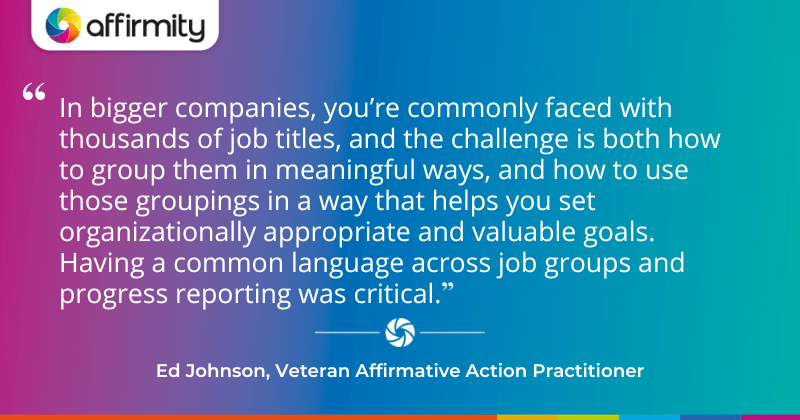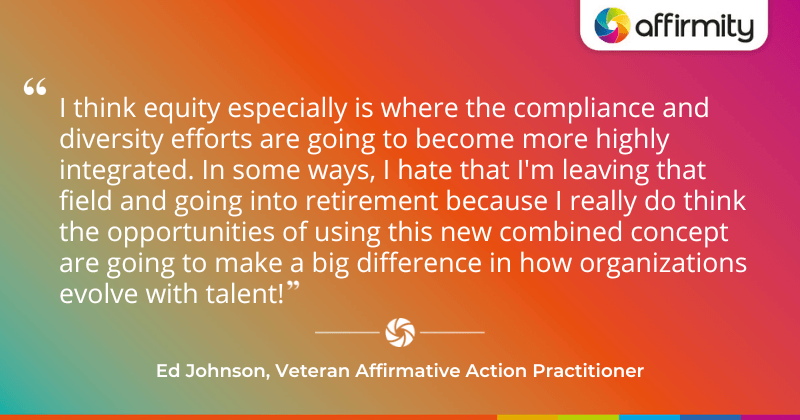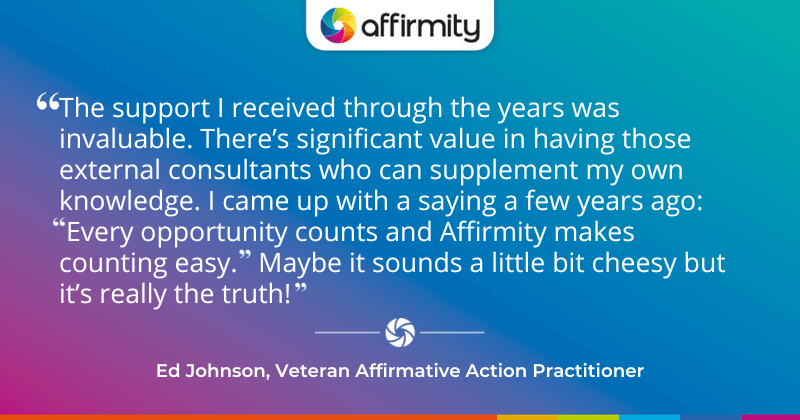A longtime Affirmity client and affirmative action peer, Ed Johnson has enjoyed a storied career as a manager and then a director of compliance and diversity, and as a consultant at and for a range of major organizations. Recently sharing his intention to retire, we couldn’t resist catching up with him for a Q&A session to—in his words—“memorialize [his] compliance career”. In this article, we’ve done just that, laying out some key insights drawn from 40 years of affirmative action best practice that you won’t want to miss!
Q: How did you get started in the field of affirmative action?
Ed Johnson: I first started doing this in 1979, and then at the corporate level in 1983. I was working for a defense and semiconductor company, with 75,000 workers. In those days, the biggest challenge was getting reports in a format that the various regions would find acceptable, and as a technology company, one point of emphasis was the lack of women in key leadership roles.
In my graduate studies, I’d learned quite a bit about equity and felt the lack of insight into that was a big gap if we were going to get leadership to embrace affirmative action. So that’s where I went—I generated job groups and showed them our weaknesses, our vulnerabilities. Candidly with the company at the time, the key thing was branding. We’d hire 5,000-7,000 graduates a year and I made it clear to them that if we wanted to attract the very best, we couldn’t have a second-rate approach to managing people’s growth in the company.
They were very receptive to that. We refined leadership job groups and metrics on a quarterly basis, and we used them in our strategic planning to work on getting more women into our leadership roles. We started creating teams where the natural progression might have been, for example, to a senior director or vice president position, and worked on getting women managers into those teams with a view to accelerating their development.
We won a Catalyst Award in 1996 for that work, on the basis of how we used our tools and reporting to accelerate women into leadership roles. After that point, any resistance to the whole concept of affirmative action naturally evaporated, and the question became, “well, how can we do it even better?”

Q: What did award-winning reporting look like in 1996?
EJ: At this point, we were working with an executive staffing and recruitment firm, and specifically with Jeffery Lewis (Affirmity’s co-managing director) on these problems. And what they did for me was kind of unique—they started giving me reports that weren’t tied to the traditional establishment. They started doing alternative reporting that looked at specific leaders so each leader could see how they were doing.
The biggest challenge with getting leaders to embrace affirmative action is with the establishment-based view, though they’re part of that structure that can’t really see how they’re doing within their own departments and divisions. Letting them see their own piece of the pie makes it a lot easier for them to embrace. From there, we could start comparing them—we ranked the top 20 leaders and helped them see how they fell relative to their progress with affirmative action goals.
The other thing that you have to overcome, even today, is that there are a lot of myths and misconceptions about affirmative action and its intentions. I’d get pushback in meetings, where leaders would ask, “why would we establish two separate standards?” It was important to help them understand that we don’t—when we create job titles and when we recruit, we have one standard that we use for everyone. The importance of corporate affirmative action operating within a common standard has only been re-emphasized in the wake of the Supreme Court’s ruling on affirmative action in universities.
So, our programs were running smoothly and we were providing information outside of the establishment-based views. Shortly afterward, the division was acquired by another defense company, which ushered in a new set of challenges.
DETAILED DATA ADVICE FROM OUR TEAM | ‘Incomplete, Inaccurate, Inconsistent: How the 3 “I”s Sow Chaos in Your Affirmative Action Data’
Q: How did your approach to affirmative action have to change with an acquisition?
EJ: This was a substantial acquisition, and there were six companies acquired in total. The work we had done was strong enough that I knew how to set up the job groups, reporting, and metrics in the new context, while the five other companies were working with older, less insightful systems and processes.
We were siloed off and each group had their existing approach to job groups—we weren’t sharing our methodologies. We had audits to run and rather than wait for direction from elsewhere in the business, we continued working on our audits as we had been doing. Over time, our way of working won out. They acquiesced and we all got onto the same tools—by that point, we were working with Jeffery Lewis and the team at PeopleFluent (Note: Affirmity was formerly a division of PeopleFluent and the team referred to here is a direct predecessor of the current team).
In bigger companies, you’re commonly faced with thousands of job titles, and the challenge is both how to group them in meaningful ways so that you can see progress, and how to use those groupings in a way that helps you set organizationally appropriate and valuable goals. Having a common language across job groups and progress reporting was critical. Even those who resisted the switch to the PeopleFluent tools for the longest time eventually became advocates for it.
Q: How did your affirmative action approach continue to evolve post-acquisition?
EJ: Once we’d established that common language and toolkit, perhaps the biggest occasion to prove how well it worked arose in 2006, when the OFCCP came up with some standards for Internet Applicant record keeping. I partnered with PeopleFluent and challenged them on what that would look like relative to our reporting. The biggest area of opportunity was in our applicant tracking system (ATS)—we were able to get quarterly reports with literally hundreds of thousands of applicants and their dispositions within those Internet Applicant guidelines.
This work, alongside our training programs, attracted a government award, The Secretary of Labor’s Opportunity Award. Once again, the question of “how do we do even better?” energized our CEO and led to further innovations over and above what we’d already achieved. At this point, PeopleFluent helped us develop per-leader metrics. In fact, they were essentially a per-leader affirmative action plan. I could take them and easily create individually tailored slides and quarterly reporting, and because they were leaders who loved metrics and objective data, they loved that.
Leaders reacted extremely positively to being shown where availability data said they could be versus where they currently were. They loved the objectivity of the tools and we got no pushback, just leaders focused on developing a strategic approach toward closing the gap.
At the same time, we started doing work with PeopleFluent around pay equity and they would do studies for us. The tools and the resources within PeopleFluent helped us address paying women fairly, which is a struggle that a lot of tech companies have traditionally had.
DISCOVER FRESH IDEAS FOR PRESENTING DATA FOR DIFFERENT GROUPS | ‘Getting the Business On Your Side: How to Talk About Affirmative Action Data With Everyone Else’
Q: Most recently, you’ve consulted within healthcare. What was it like to start this process again in a new industry?
EJ: Well, I retired in 2012, but I came back two years later and went to work with a healthcare service corporation. They were using a different company for their affirmative action planning, and after taking stock of where they stood, I steered us back toward PeopleFluent—or Affirmity as they’d become later in the relationship—again on the strength of the support and resources I’d received in the past.
As before, the leadership reports that Affirmity developed to supplement the establishment-based reporting made it very easy for our leaders to embrace what we were doing. Around this time, we also started working with Circa—who have partnered with Affirmity for several years now—to find outreach targets and track our efforts.
It’s important to regularly revisit and reevaluate the partnerships we have with providers like Affirmity and Circa, so I was always considering the plusses of our relationship. We really valued the high level of precision we had in understanding our job sources and availabilities. We had a high level of confidence that when we set a goal, it was reflective of available pools and a major statistically significant need. Leadership buy-in is only possible when you talk their language, and Affirmity allows us to talk that language really easily.
LEARN MORE ABOUT MONITORING OUTREACH | ‘4 Reporting Views That Will Help You Better Monitor Your Affirmative Action Outreach Efforts’
Q: How important has external expertise been to your execution of affirmative action work?
EJ: The support I received through the years, from PeopleFluent and its predecessor companies, and later from Affirmity, was invaluable. Obviously, I’ve mentioned Jeffery Lewis, but I had great support in customizing reports from Joy Itoman, Zoe Ann Whitley, Sally Hill, Kelly Matthews Morris, and from Charles McGhee with regard to pay equity. There’s significant value in having those external consultants who can supplement my own knowledge. You can use them as much as you want, and I enjoyed highly productive partnerships with them.
Some companies won’t have someone like me in a role dedicated to this work, and for them, the consultants step up and play an even bigger role. I came up with a saying a few years ago: “Every opportunity counts and Affirmity makes counting easy”. Maybe it sounds a little bit cheesy but it’s really the truth!
Q: How important is it for organizations to work outside the confines of establishment-based affirmative action plans?
EJ: One thing I’ve heard throughout my career is “Ed, there cannot be metrics for everything. There are some things you can’t measure”. Well, I believe that’s bull!
When it comes to human resources, if you have a good partner, you can measure just about anything. For our own internal purposes, Affirmity was able to treat the company like it was one big establishment: we could see all the company at a glance, in a format that wouldn’t overwhelm the CEO, and helped us identify our problem areas. It was like having a “one company AAP”. It made it easy to sell the program when you have quality metrics like that.
It was very valuable having these customized reports available to our leaders in addition to the establishment-based AAPs we’re obliged to produce. It’s true that establishment-based plans aren’t the only option available in compliance terms. Though, when the government gave contractors the option of creating functional AAPs, they were kind of the vast unknown.
You’re giving so much discretion in how they manage that type of audit. Under a functional AAP, you could have 10,000 decisions made for one job group, and it would be really easy to be flagged—the larger your job groups get, the tighter the tolerance in terms of variance becomes. With large samples, you can get to the “two standard deviations” very quickly.
If they see a problem, the solution could be millions of dollars. I wasn’t inclined to expose the company to that with so many unknowns—and with an additional private layer of customized reports available, we didn’t have to.

Q: How does compliance relate to the wider topic of DE&I?
EJ: During my career I wore two hats—at the second company I was a director over compliance and diversity, and let me tell you, a lot of times those two groups don’t want to connect! One leader once said: “you do compliance because you have to, but we want to do diversity because it’s the right thing”. The truth is you cannot do a good job with diversity if you don’t have a good baseline of compliance.
If you don’t know where your gaps are, you can have the best intentions in the world from a diversity perspective but the program’s not going to have any real momentum because you don’t understand where your true weaknesses lie. I believe the two are complementary to each other, and I think there’s a synergy that you can’t get if you work on each one separately.
There’s maybe a tendency for people on the diversity side of things to be less comfortable working with metrics and embracing data. Certainly, this is improving in many companies, but it still remains an area for improvement in many others. There is danger in saying “we want half of all our college hires to be women in 2024” and having no objective basis for that. Now, with the data, I can tell you that the real number should be 43.8% and I can objectively defend that if someone were to accuse us of doing reverse discrimination. It’s important for everyone to start thinking that way.
That was the biggest challenge in the diversity world about five, ten years ago. But now, because of companies like Affirmity, they can get and use the data when they need it. The conversation has evolved to include inclusion, equity, and belonging, and across all these areas, we have to avoid pitting one group against another—if we do, we create more of a problem than a solution.
Wherever there’s competition, you have to ensure you provide comparable resources for those competing. In the working world that might be development, or immersion in a particular technology that a person may not have had exposure to before. I think equity especially is where the compliance and diversity efforts are going to become more highly integrated.
In some ways, I hate that I’m leaving that field and going into retirement because I really do think the opportunities of using this new combined concept are going to make a big difference in how organizations evolve with talent!
GET THESE PAY EQUITY INSIGHTS | ‘A 5-Point Plan for Designing a Culture That Embraces Pay Equity’
Q: Do you have any advice for anyone exploring those opportunities for combining their compliance and diversity efforts?
EJ: Something I got used to seeing, especially in large corporate and outsourcing contexts, were stovepipe functions within HR. The people who lead diversity think it’s totally unique and that compliance is its own stovepipe. One manages everything about diversity, equity, and inclusion. The other concerns itself with managing audits and reporting.
The challenge is, how do you get those people to break those stovepipes and start talking to each other? Because even if you don’t combine them, you can at least partner in fulfilling both missions. So consider how you get them to start talking, and to let go of the idea that they already have the best possible program, and that weaving any other programs with their program would be detrimental.
In those situations, that’s where you need the Chief Human Resources Officer to be aware of the case for integration, and to push teams to make such a partnership work. Because it can work, and it will work, and the synergy of combining them would really accelerate these companies and better meet the objectives of both in key areas.
The Affirmity team would like to thank Ed for sharing his insights, and we offer our best wishes for his retirement. If you’d like to learn more about the affirmative action approaches discussed in this interview, contact us today.
About the Author
 Kim Hendon oversees account management and sales for Affirmity as Vice President of Sales. Having served with the company for more than 20 years, Ms. Hendon has in-depth knowledge and broad experience in all areas of compliance and diversity. Ms. Hendon assists clients with planning and development of affirmative action programs, diversity initiatives, and diversity training. She holds a Bachelor of Arts in Speech Communication and a Master’s in Business Administration.
Kim Hendon oversees account management and sales for Affirmity as Vice President of Sales. Having served with the company for more than 20 years, Ms. Hendon has in-depth knowledge and broad experience in all areas of compliance and diversity. Ms. Hendon assists clients with planning and development of affirmative action programs, diversity initiatives, and diversity training. She holds a Bachelor of Arts in Speech Communication and a Master’s in Business Administration.

